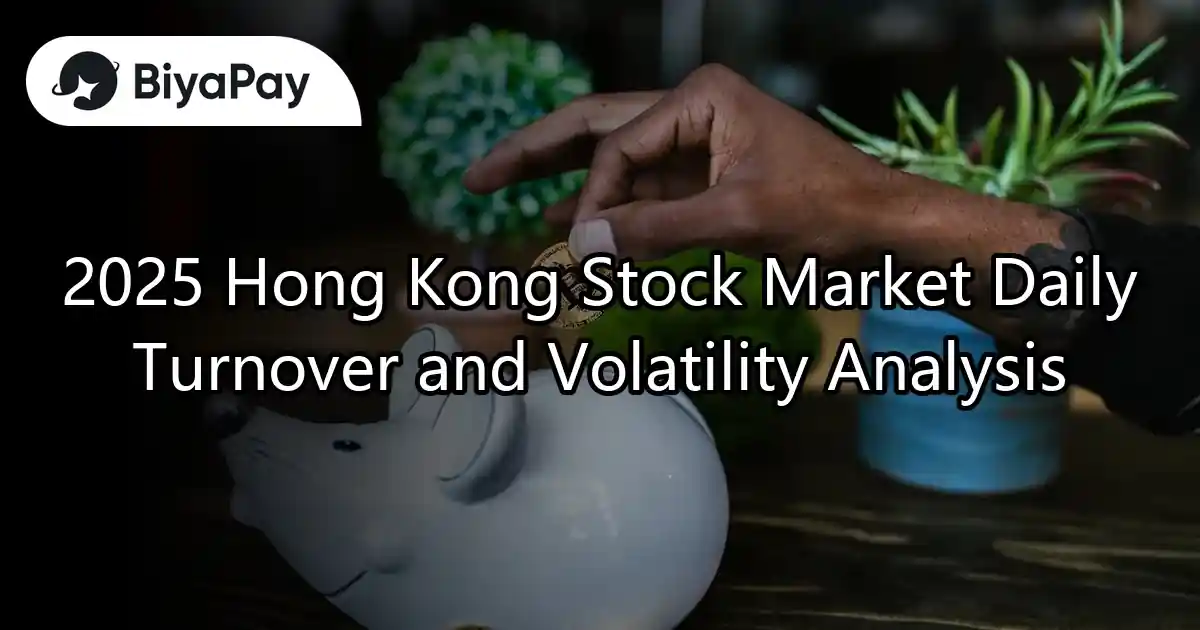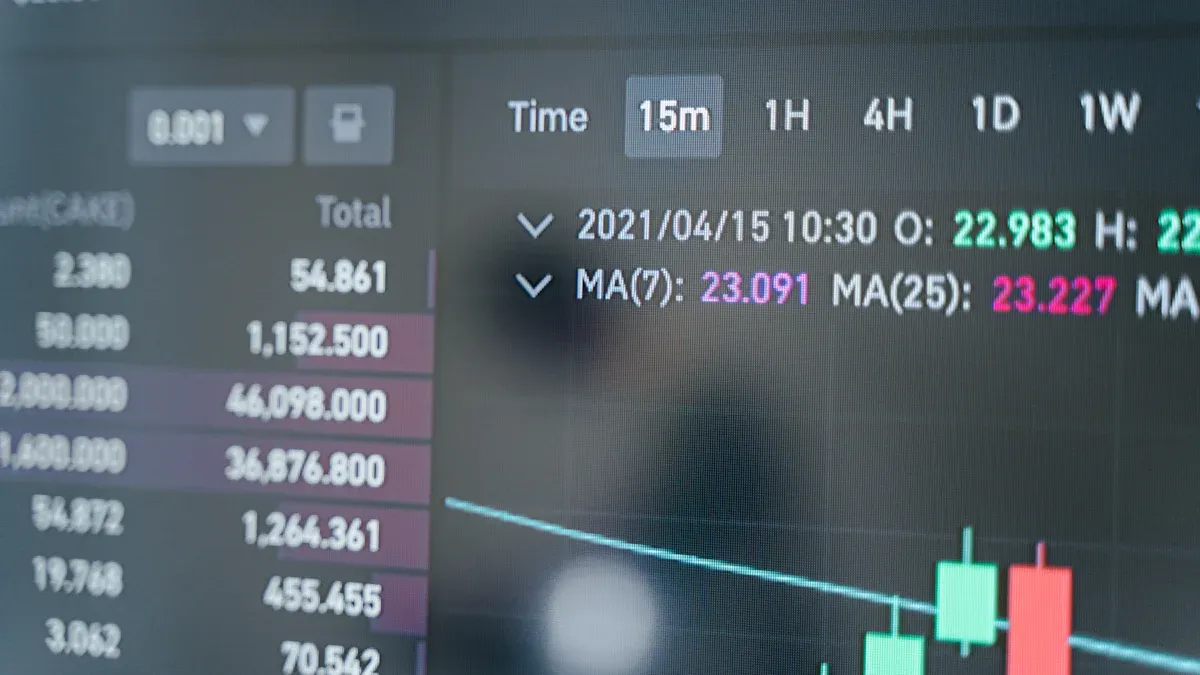- EasyCard
- Trade
- Help
- Announcement
- Academy
- SWIFT Code
- Iban Number
- Referral
- Customer Service
- Blog
- Creator
2025 Hong Kong Stock Market Daily Turnover and Volatility Analysis

Image Source: pexels
In 2025, the Hong Kong stock market’s daily average turnover shows significant changes, reflecting an increase in market activity. Volatility has become an important factor influencing the market, directly altering investors’ decision-making patterns. You may notice that global economic policies, technological innovation, and regional economic cooperation are driving the long-term development of the market.
Key Points
- In 2025, the Hong Kong stock market’s daily turnover exceeds USD 20 billion, indicating a significant increase in market activity, particularly in technology and new energy sectors.
- Increased volatility affects investor behavior, with a preference for defensive assets and short-term trading, providing arbitrage opportunities.
- Adopting strategies such as long-term holding of quality assets, contrarian investing, and diversified investments can reduce risks and achieve stable growth in a volatile market.
Trends and Impacts of Daily Turnover in the Hong Kong Stock Market

Image Source: pexels
Overall Changes in Daily Turnover in 2025
In 2025, the daily turnover of the Hong Kong stock market shows steady growth. You will find that market activity has significantly increased, especially in trading within the technology and new energy sectors. These sectors have attracted substantial capital inflows, driving the overall rise in turnover. According to the latest data, the daily average turnover has exceeded USD 20 billion, representing an approximately 15% increase compared to 2024. This growth reflects investors’ confidence in the Hong Kong stock market and its important position in global capital flows.
Key Factors Influencing Turnover
The factors influencing the daily turnover of the Hong Kong stock market are diverse. You may notice that changes in global economic policies are one of them. For example, U.S. interest rate hikes and China’s economic recovery directly affect capital flows. Additionally, as an international financial hub, Hong Kong’s unique geographical location and policy advantages attract significant foreign investment. Technological innovation is also a key driver. The application of artificial intelligence and blockchain technologies has boosted the stock prices of related companies, further increasing turnover.
Comparison with Historical Data
Compared to data from the past five years, the daily turnover in 2025 shows a significant growth trend. You can see that from 2019 to 2023, the daily average turnover fluctuated between USD 15 billion and USD 18 billion. In contrast, the 2025 figure not only surpasses USD 20 billion but also sets a historical record. This growth not only reflects market activity but also indicates the increasing importance of the Hong Kong stock market in global capital markets.
Volatility Analysis of the Hong Kong Stock Market

Image Source: pexels
Main Drivers of Volatility
You may have noticed that the volatility of the Hong Kong stock market in 2025 is particularly pronounced. This volatility is primarily driven by several key factors:
- International Trade Situation: Uncertainty in global trade policies directly impacts market sentiment. For example, progress in U.S.-China trade negotiations often triggers short-term fluctuations in Hong Kong stocks.
- Global Macroeconomic Trends: Slower economic growth makes investors more cautious about future expectations, leading to increased market volatility.
- Federal Reserve Monetary Policy: News of interest rate hikes or cuts typically transmits quickly to the Hong Kong stock market, affecting capital flows.
- U.S. Stock Market Trends: Technical corrections in the U.S. market, such as the recent S&P 500 falling over 10% from its high, also have a ripple effect on the Hong Kong stock market.
Nevertheless, the Hong Kong stock market still demonstrates a degree of resilience. The Hang Seng Index has risen 13% since the beginning of the year, tying with Germany’s DAX Index as one of the best-performing markets globally. This indicates that the Hong Kong stock market remains attractive despite global economic uncertainties.
Impact of Volatility on Investor Behavior
Volatility not only affects the market itself but also profoundly changes investors’ behavior patterns. When market volatility intensifies, you may observe the following typical behaviors:
- Reduced Risk Appetite: Investors tend to prefer defensive assets, such as utility stocks or high-dividend stocks.
- Increased Short-Term Trading: Volatility provides more arbitrage opportunities, attracting short-term traders to the market.
- Shifts in Capital Flows: When uncertainty from news increases, capital often flows to safe-haven assets, such as the U.S. dollar or gold.
However, the stability of fundamentals still offers long-term investors opportunities for positioning. Based on past market experiences, volatility triggered by news often presents good entry points for medium- to long-term investments.
Investment Strategies to Address Volatility
In the face of market volatility, you can adopt the following strategies to reduce risks and achieve stable growth:
- Long-Term Holding of Quality Assets: Historical data shows that portfolios holding quality assets for over 20 years typically achieve returns five times higher than fixed deposit rates over the same period.
- Contrarian Investing: Peter Lynch continued to buy during the 1987 market crash, achieving a 23-fold return over the next decade. This suggests that contrarian investing during market panic can yield substantial returns.
- Diversified Investments: Allocating capital across different sectors and regions can effectively reduce risks from single-market volatility.
- Focus on Fundamentals: During the 2008 financial crisis, Warren Buffett heavily invested in Goldman Sachs preferred shares, ultimately achieving an annualized 10% special dividend. This shows that focusing on companies with strong fundamentals is an effective strategy for addressing volatility.
Through these strategies, you can find stable investment opportunities in a highly volatile market while reducing risks.
In 2025, the Hong Kong stock market’s daily turnover exceeds USD 20 billion, indicating increased market activity. While volatility has intensified, it also brings investment opportunities. Going forward, you should focus on the potential of technology and new energy sectors. Meanwhile, adopting diversified investments and focusing on fundamentals will help achieve stable growth amid uncertainty.
FAQ
1. Is the Volatility of the Hong Kong Stock Market Suitable for Novice Investors?
Volatility offers short-term opportunities but comes with higher risks. You should first learn fundamental analysis and adopt diversified investment strategies to reduce risks.
2. How to Select Hong Kong Stocks Suitable for Long-Term Holding?
Choose companies with strong fundamentals, such as technology stocks or high-dividend stocks. You can refer to financial statements and industry prospects.
3. Does the Turnover of the Hong Kong Stock Market Affect Stock Price Trends?
Turnover reflects market activity. High turnover often accompanies stock price fluctuations, but you need to combine fundamental analysis to judge price trends.
In 2025, Hong Kong’s stock market daily turnover exceeds $20 billion, with heightened volatility creating opportunities in tech and renewable energy sectors, and an efficient, low-cost financial platform can help you stay ahead. BiyaPay offers a seamless trading solution, enabling trading in U.S. and Hong Kong stocks without offshore accounts, allowing you to participate in the market cost-effectively, whether capitalizing on short-term volatility for arbitrage opportunities or investing long-term in tech and renewable energy for stable growth.
Its platform supports USD, HKD, and 30+ fiat and digital currencies with real-time exchange rate insights, helping you navigate exchange rate risks in cross-border trading while ensuring efficient fund flows. With remittance fees as low as 0.5% across 190+ countries, it simplifies fund allocation without high costs eroding profits. A flexible 5.48% annualized yield savings product with no lock-in period ensures idle funds grow during market timing or volatile trading, perfectly aligning with the dynamic needs of Hong Kong’s market. Sign up for BiyaPay today to combine the vibrant trends of Hong Kong’s market with BiyaPay’s efficient tools for a flexible, robust investment journey!
*This article is provided for general information purposes and does not constitute legal, tax or other professional advice from BiyaPay or its subsidiaries and its affiliates, and it is not intended as a substitute for obtaining advice from a financial advisor or any other professional.
We make no representations, warranties or warranties, express or implied, as to the accuracy, completeness or timeliness of the contents of this publication.




Contact Us
Company and Team
BiyaPay Products
Customer Services
is a broker-dealer registered with the U.S. Securities and Exchange Commission (SEC) (No.: 802-127417), member of the Financial Industry Regulatory Authority (FINRA) (CRD: 325027), member of the Securities Investor Protection Corporation (SIPC), and regulated by FINRA and SEC.
registered with the US Financial Crimes Enforcement Network (FinCEN), as a Money Services Business (MSB), registration number: 31000218637349, and regulated by FinCEN.
registered as Financial Service Provider (FSP number: FSP1007221) in New Zealand, and is a member of the Financial Dispute Resolution Scheme, a New Zealand independent dispute resolution service provider.



















